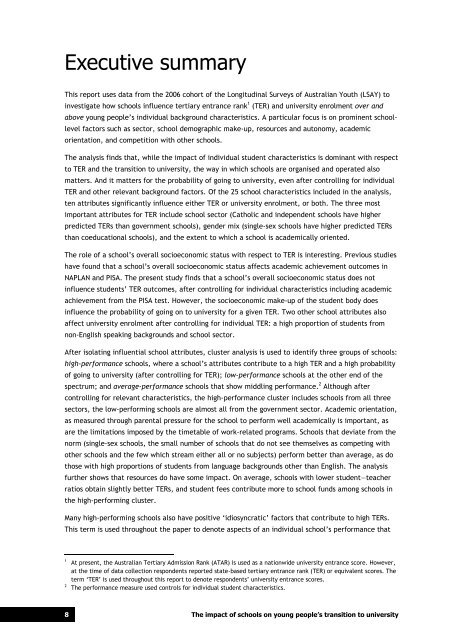The impact of schools on young people's transition to university
The impact of schools on young people's transition to university
The impact of schools on young people's transition to university
Create successful ePaper yourself
Turn your PDF publications into a flip-book with our unique Google optimized e-Paper software.
Executive summary<br />
This report uses data from the 2006 cohort <str<strong>on</strong>g>of</str<strong>on</strong>g> the L<strong>on</strong>gitudinal Surveys <str<strong>on</strong>g>of</str<strong>on</strong>g> Australian Youth (LSAY) <strong>to</strong><br />
investigate how <str<strong>on</strong>g>schools</str<strong>on</strong>g> influence tertiary entrance rank 1 (TER) and <strong>university</strong> enrolment over and<br />
above <strong>young</strong> people’s individual background characteristics. A particular focus is <strong>on</strong> prominent schoollevel<br />
fac<strong>to</strong>rs such as sec<strong>to</strong>r, school demographic make-up, resources and aut<strong>on</strong>omy, academic<br />
orientati<strong>on</strong>, and competiti<strong>on</strong> with other <str<strong>on</strong>g>schools</str<strong>on</strong>g>.<br />
<str<strong>on</strong>g>The</str<strong>on</strong>g> analysis finds that, while the <str<strong>on</strong>g>impact</str<strong>on</strong>g> <str<strong>on</strong>g>of</str<strong>on</strong>g> individual student characteristics is dominant with respect<br />
<strong>to</strong> TER and the transiti<strong>on</strong> <strong>to</strong> <strong>university</strong>, the way in which <str<strong>on</strong>g>schools</str<strong>on</strong>g> are organised and operated also<br />
matters. And it matters for the probability <str<strong>on</strong>g>of</str<strong>on</strong>g> going <strong>to</strong> <strong>university</strong>, even after c<strong>on</strong>trolling for individual<br />
TER and other relevant background fac<strong>to</strong>rs. Of the 25 school characteristics included in the analysis,<br />
ten attributes significantly influence either TER or <strong>university</strong> enrolment, or both. <str<strong>on</strong>g>The</str<strong>on</strong>g> three most<br />
important attributes for TER include school sec<strong>to</strong>r (Catholic and independent <str<strong>on</strong>g>schools</str<strong>on</strong>g> have higher<br />
predicted TERs than government <str<strong>on</strong>g>schools</str<strong>on</strong>g>), gender mix (single-sex <str<strong>on</strong>g>schools</str<strong>on</strong>g> have higher predicted TERs<br />
than coeducati<strong>on</strong>al <str<strong>on</strong>g>schools</str<strong>on</strong>g>), and the extent <strong>to</strong> which a school is academically oriented.<br />
<str<strong>on</strong>g>The</str<strong>on</strong>g> role <str<strong>on</strong>g>of</str<strong>on</strong>g> a school’s overall socioec<strong>on</strong>omic status with respect <strong>to</strong> TER is interesting. Previous studies<br />
have found that a school’s overall socioec<strong>on</strong>omic status affects academic achievement outcomes in<br />
NAPLAN and PISA. <str<strong>on</strong>g>The</str<strong>on</strong>g> present study finds that a school’s overall socioec<strong>on</strong>omic status does not<br />
influence students’ TER outcomes, after c<strong>on</strong>trolling for individual characteristics including academic<br />
achievement from the PISA test. However, the socioec<strong>on</strong>omic make-up <str<strong>on</strong>g>of</str<strong>on</strong>g> the student body does<br />
influence the probability <str<strong>on</strong>g>of</str<strong>on</strong>g> going <strong>on</strong> <strong>to</strong> <strong>university</strong> for a given TER. Two other school attributes also<br />
affect <strong>university</strong> enrolment after c<strong>on</strong>trolling for individual TER: a high proporti<strong>on</strong> <str<strong>on</strong>g>of</str<strong>on</strong>g> students from<br />
n<strong>on</strong>-English speaking backgrounds and school sec<strong>to</strong>r.<br />
After isolating influential school attributes, cluster analysis is used <strong>to</strong> identify three groups <str<strong>on</strong>g>of</str<strong>on</strong>g> <str<strong>on</strong>g>schools</str<strong>on</strong>g>:<br />
high-performance <str<strong>on</strong>g>schools</str<strong>on</strong>g>, where a school’s attributes c<strong>on</strong>tribute <strong>to</strong> a high TER and a high probability<br />
<str<strong>on</strong>g>of</str<strong>on</strong>g> going <strong>to</strong> <strong>university</strong> (after c<strong>on</strong>trolling for TER); low-performance <str<strong>on</strong>g>schools</str<strong>on</strong>g> at the other end <str<strong>on</strong>g>of</str<strong>on</strong>g> the<br />
spectrum; and average-performance <str<strong>on</strong>g>schools</str<strong>on</strong>g> that show middling performance. 2 Although after<br />
c<strong>on</strong>trolling for relevant characteristics, the high-performance cluster includes <str<strong>on</strong>g>schools</str<strong>on</strong>g> from all three<br />
sec<strong>to</strong>rs, the low-performing <str<strong>on</strong>g>schools</str<strong>on</strong>g> are almost all from the government sec<strong>to</strong>r. Academic orientati<strong>on</strong>,<br />
as measured through parental pressure for the school <strong>to</strong> perform well academically is important, as<br />
are the limitati<strong>on</strong>s imposed by the timetable <str<strong>on</strong>g>of</str<strong>on</strong>g> work-related programs. Schools that deviate from the<br />
norm (single-sex <str<strong>on</strong>g>schools</str<strong>on</strong>g>, the small number <str<strong>on</strong>g>of</str<strong>on</strong>g> <str<strong>on</strong>g>schools</str<strong>on</strong>g> that do not see themselves as competing with<br />
other <str<strong>on</strong>g>schools</str<strong>on</strong>g> and the few which stream either all or no subjects) perform better than average, as do<br />
those with high proporti<strong>on</strong>s <str<strong>on</strong>g>of</str<strong>on</strong>g> students from language backgrounds other than English. <str<strong>on</strong>g>The</str<strong>on</strong>g> analysis<br />
further shows that resources do have some <str<strong>on</strong>g>impact</str<strong>on</strong>g>. On average, <str<strong>on</strong>g>schools</str<strong>on</strong>g> with lower student—teacher<br />
ratios obtain slightly better TERs, and student fees c<strong>on</strong>tribute more <strong>to</strong> school funds am<strong>on</strong>g <str<strong>on</strong>g>schools</str<strong>on</strong>g> in<br />
the high-performing cluster.<br />
Many high-performing <str<strong>on</strong>g>schools</str<strong>on</strong>g> also have positive ‘idiosyncratic’ fac<strong>to</strong>rs that c<strong>on</strong>tribute <strong>to</strong> high TERs.<br />
This term is used throughout the paper <strong>to</strong> denote aspects <str<strong>on</strong>g>of</str<strong>on</strong>g> an individual school’s performance that<br />
1<br />
2<br />
At present, the Australian Tertiary Admissi<strong>on</strong> Rank (ATAR) is used as a nati<strong>on</strong>wide <strong>university</strong> entrance score. However,<br />
at the time <str<strong>on</strong>g>of</str<strong>on</strong>g> data collecti<strong>on</strong> resp<strong>on</strong>dents reported state-based tertiary entrance rank (TER) or equivalent scores. <str<strong>on</strong>g>The</str<strong>on</strong>g><br />
term ‘TER’ is used throughout this report <strong>to</strong> denote resp<strong>on</strong>dents’ <strong>university</strong> entrance scores.<br />
<str<strong>on</strong>g>The</str<strong>on</strong>g> performance measure used c<strong>on</strong>trols for individual student characteristics.<br />
8 <str<strong>on</strong>g>The</str<strong>on</strong>g> <str<strong>on</strong>g>impact</str<strong>on</strong>g> <str<strong>on</strong>g>of</str<strong>on</strong>g> <str<strong>on</strong>g>schools</str<strong>on</strong>g> <strong>on</strong> <strong>young</strong> people’s transiti<strong>on</strong> <strong>to</strong> <strong>university</strong>


